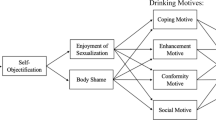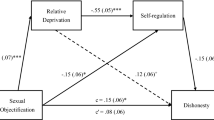Abstract
Self-objectification is associated with a number of negative mental and behavioral outcomes. Though previous research has established associations between self-objectification and risky sex, no study to date has examined whether self-objectification affects propensity to engage in risky sex. The current research employed an experimental design to examine the effect of heightened self-objectification on a laboratory analog of risky sex (n = 181). We observed that when college-attending women experienced a heightened state of self-objectification, they were more likely to engage in sex without a condom and less likely to wait to use a condom with a highly desirable partner. Given the frequency of intended and unintended objectifying messages that young women face, this increase in willingness to engage in risky sex behavior represents a consequential health concern.




Similar content being viewed by others
Availability of Data and Materials
Not applicable.
Code Availability
Not applicable.
References
Agocha, V. B., & Cooper, M. L. (1999). Risk perceptions and safer-sex intentions: Does a partner’s physical attractiveness undermine the use of risk-relevant information? Personality and Social Psychology Bulletin, 25(6), 751–765.
Arechar, A. A., Gächter, S., & Molleman, L. (2018). Conducting interactive experiments online. Experimental Economics, 21(1), 99–131.
American Psychological Association, Task Force on the Sexualization of Girls. (2008). Report of the APA Task Force on the Sexualization of Girls. Retrieved from http://www.apa.org/pi/women/programs/girls/report-full.pdf
Aubrey, J. S. (2006). Effects of sexually objectifying media on self-objectification and body surveillance undergraduates: Results of a 2 year panel study. Journal of Communication, 56(2), 366–386.
Aubrey, J. S., & Frisby, C. M. (2011). Sexual objectification in music videos: A content analysis comparing gender and genre. Mass Communication and Society, 14(4), 475–501.
Aubrey, J. S., & Gerding, A. (2015). The cognitive tax of self-objectification: Examining sexually objectifying music videos and female emerging adults’ cognitive processing of subsequent advertising. Journal of Media Psychology, 27, 22–32.
Bartky, S. L. (1990). Femininity and domination: Studies in the phenomenology of oppression. Routledge.
Berenson, K. R., Paprocki, C., Fishman, M., Bhushan, D., El-Bassel, N., & Downey, G. (2015). Rejection sensitivity, perceived power, and HIV risk in the relationships of low-income urban women. Women and Health, 55(8), 900–920.
Bickel, W. K., Jarmolowicz, D. P., Mueller, E. T., Koffarnus, M. N., & Gatchalian, K. M. (2012). Excessive discounting of delayed reinforcers as a trans-disease process contributing to addiction and other disease-related vulnerabilities: Emerging evidence. Pharmacology & Therapeutics, 134(3), 287–297.
Blashill, A. J., & Safren, S. A. (2015). Body dissatisfaction and condom use self-efficacy: A meta-analysis. Body Image, 12, 73–77.
Borges, A. M., Kuang, J., Milhorn, H., & Yi, R. (2016). An alternative approach to calculating Area-Under-the-Curve (AUC) in delay discounting research. Journal of the Experimental Analysis of Behavior, 106(2), 145–155.
Centers for Disease Control and Prevention. (2011). Control HIV/STD Behavioral Surveillance Working Group. Sexual behavior questions. Retrieved from http://chipts.ucla.edu/wp-content/uploads/downloads/2012/01/CDC-Sexual-Behavior-Questions-CSBQ.pdf
Centers for Disease Control and Prevention. (2014). Sexually transmitted disease surveillance 2013. Retrieved from http://www.cdc.gov/std/stats13/adol.htm
Collado, A., Johnson, P. S., Loya, J. M., Johnson, M. W., & Yi, R. (2017). Discounting of condom-protected sex as a measure of high risk for sexually transmitted infection among college students. Archives of Sexual Behavior, 46(7), 2187–2195.
Collins, R. L. (2011). Content analysis of gender roles in media: Where are we now and where should we go? Sex Roles, 64(3–4), 290–298.
Dariotis, J. K., & Johnson, M. W. (2015). Sexual discounting among high-risk youth ages 18–24: Implications for sexual and substance use risk behaviors. Experimental and Clinical Psychopharmacology, 23(1), 49–58.
Deaux, K., & Major, B. (1987). Putting gender into context: An interactive model of gender-related behavior. Psychological Review, 94(3), 369–389.
Eleftheriou, A., Bullock, S., Graham, C. A., Stone, N., & Ingham, R. (2016). Does attractiveness influence condom use intentions in heterosexual men? An experimental study. British Medical Journal Open, 6(6), e010883. https://doi.org/10.1136/bmjopen-2015-010883
Fielder, R. L., Walsh, J. L., Carey, K. B., & Carey, M. P. (2014). Sexual hookups and adverse health outcomes: A longitudinal study of first-year college women. Journal of Sex Research, 51(2), 131–144.
Fitzsimmons-Craft, E. E. (2011). Social psychological theories of disordered eating in college women: Review and integration. Clinical Psychology Review, 31(7), 1224–1237.
Fredrickson, B. L., & Roberts, T.-A. (1997). Objectification theory: Toward understanding women’s lived experiences and mental health risks. Psychology of Women Quarterly, 21(2), 173–206.
Fredrickson, B. L., Roberts, T. A., Noll, S. M., Quinn, D. M., & Twenge, J. M. (1998). That swimsuit becomes you: Sex differences in self-objectification, restrained eating, and math performance. Journal of Personality and Social Psychology, 75(1), 269–284.
Frick, A., Bächtiger, M. T., & Reips, U. D. (2001). Financial incentives, personal information and dropout in online studies. In U.-D. Reips & M. Bosnjak (Eds.), Dimensions of internet science (pp. 209–219). Pabst.
Gay, R. K., & Castano, E. (2010). My body or my mind: The impact of state and trait objectification on women’s cognitive resources. European Journal of Social Psychology, 40(5), 695–703.
Gervais, S. J., Vescio, T. K., & Allen, J. (2011). When what you see is what you get: The consequences of the objectifying gaze for women and men. Psychology of Women Quarterly, 35(1), 5–17.
Gervais, S. J., Wiener, R. L., Allen, J., Farnum, K. S., & Kimble, K. (2016). Do you see what I see? The consequences of objectification in work settings for experiencers and third-party predictors. Analyses of Social Issues and Public Policy, 16(1), 143–174.
Grabe, S., Ward, L. M., & Hyde, J. S. (2008). The role of the media in body image concerns among women: A meta-analysis of experimental and correlational studies. Psychological Bulletin, 134(3), 460–476.
Graff, K. A., Murnen, S. K., & Krause, A. K. (2013). Low-cut shirts and high-heeled shoes: Increased sexualization across time in magazine depictions of girls. Sex Roles, 69(11–12), 571–582.
Harper, B., & Tiggemann, M. (2007). The effect of thin ideal media images on women’s self-objectification, mood, and body image. Sex Roles, 58(9–10), 649–657.
Hebl, M. R., King, E. B., & Lin, J. (2004). The swimsuit becomes us all: Ethnicity, gender, and vulnerability to self-objectification. Personality and Social Psychology Bulletin, 30, 1322–1331.
Herrmann, E. S., Johnson, P. S., & Johnson, M. W. (2015). Examining delay discounting of condom-protected sex among men who have sex with men using crowdsourcing technology. AIDS and Behavior, 19(9), 1655–1665.
Impett, E. A., Schooler, D., & Tolman, D. L. (2006). To be seen and not heard: Femininity ideology and adolescent girls’ sexual health. Archives of Sexual Behavior, 35(2), 129–142.
Johnson, M. W., & Bickel, W. K. (2008). An algorithm for identifying nonsystematic delay-discounting data. Experimental and Clinical Psychopharmacology, 16(3), 264–274.
Johnson, M. W., & Bruner, N. R. (2013). Test-retest reliability and gender differences in the sexual discounting task among cocaine-dependent individuals. Experimental and Clinical Psychopharmacology, 21(4), 277–286.
Johnson, P. S., Sweeney, M. M., Herrmann, E. S., & Johnson, M. W. (2016). Alcohol increases delay and probability discounting of condom-protected sex: A novel vector for alcohol-related HIV transmission. Alcoholism: Clinical and Experimental Research, 40(6), 1339–1350.
Jones, B. A., & Griffiths, K. M. (2015). Self-objectification and depression: An integrative systematic review. Journal of Affective Disorders, 171, 22–32.
Kuhn, M. H., & McPartland, T. S. (1954). An empirical investigation of self-attitudes. American Sociological Review, 19(1), 68–76.
Leval, A., Sundström, K., Ploner, A., Dahlström, L. A., Widmark, C., & Sparén, P. (2011). Assessing perceived risk and STI prevention behavior: A national population-based study with special reference to HPV. PLoS ONE, 6(6), e20624. https://doi.org/10.1371/journal.pone.0020624
Littleton, H., Breitkopf, C. R., & Berenson, A. (2005). Body image and risky sexual behaviors: An investigation in a tri-ethnic sample. Body Image, 2(2), 193–198.
McKinley, N. M., & Hyde, J. S. (1996). The objectified cody consciousness scale development and validation. Psychology of Women Quarterly, 20(2), 181–215.
Parent, M. C., & Moradi, B. (2015). Self-objectification and condom use self-efficacy in women university students. Archives of Sexual Behavior, 44(4), 971–981.
Rodgers, R. F., & Melioli, T. (2016). The relationship between body image concerns, eating disorders and internet use, part I: A review of empirical support. Adolescent Research Review, 1(2), 95–119.
Skakoon-Sparling, S., Cramer, K. M., & Shuper, P. A. (2016). The impact of sexual arousal on sexual risk-taking and decision-making in men and women. Archives of Sexual Behavior, 45(1), 33–42.
Tiggemann, M., & Lynch, J. E. (2001). Body image across the life span in adult women: The role of self-objectification. Developmental Psychology, 37(2), 243–253.
Funding
Not applicable.
Author information
Authors and Affiliations
Contributions
KI, RY, and AC contributed to the study conception and design. KI facilitated data collection, with supervision and support from AC and RY. Data analysis was performed by JF and KI. The first draft of the manuscript was written by KI, and all authors offered substantial revisions. All authors read and approved the final manuscript.
Corresponding author
Ethics declarations
Conflict of interest
All authors report no conflicts of interest.
Ethical Approval
All procedures performed in studies involving human participants were in accordance with the ethical standards of the institutional and/or national research committee and with the 1964 Helsinki declaration and its later amendments or comparable ethical standards.
Informed Consent
Informed consent was obtained from all individual participants included in the study.
Additional information
Publisher's Note
Springer Nature remains neutral with regard to jurisdictional claims in published maps and institutional affiliations.
Rights and permissions
Springer Nature or its licensor (e.g. a society or other partner) holds exclusive rights to this article under a publishing agreement with the author(s) or other rightsholder(s); author self-archiving of the accepted manuscript version of this article is solely governed by the terms of such publishing agreement and applicable law.
About this article
Cite this article
Ingram, K.M., Collado, A., Felton, J.W. et al. A Preliminary Experimental Study of Self-Objectification and Risky Sex Behavior Among a University Sample of Cisgender Women in the U.S.. Arch Sex Behav 52, 1643–1651 (2023). https://doi.org/10.1007/s10508-022-02510-5
Received:
Revised:
Accepted:
Published:
Issue Date:
DOI: https://doi.org/10.1007/s10508-022-02510-5




